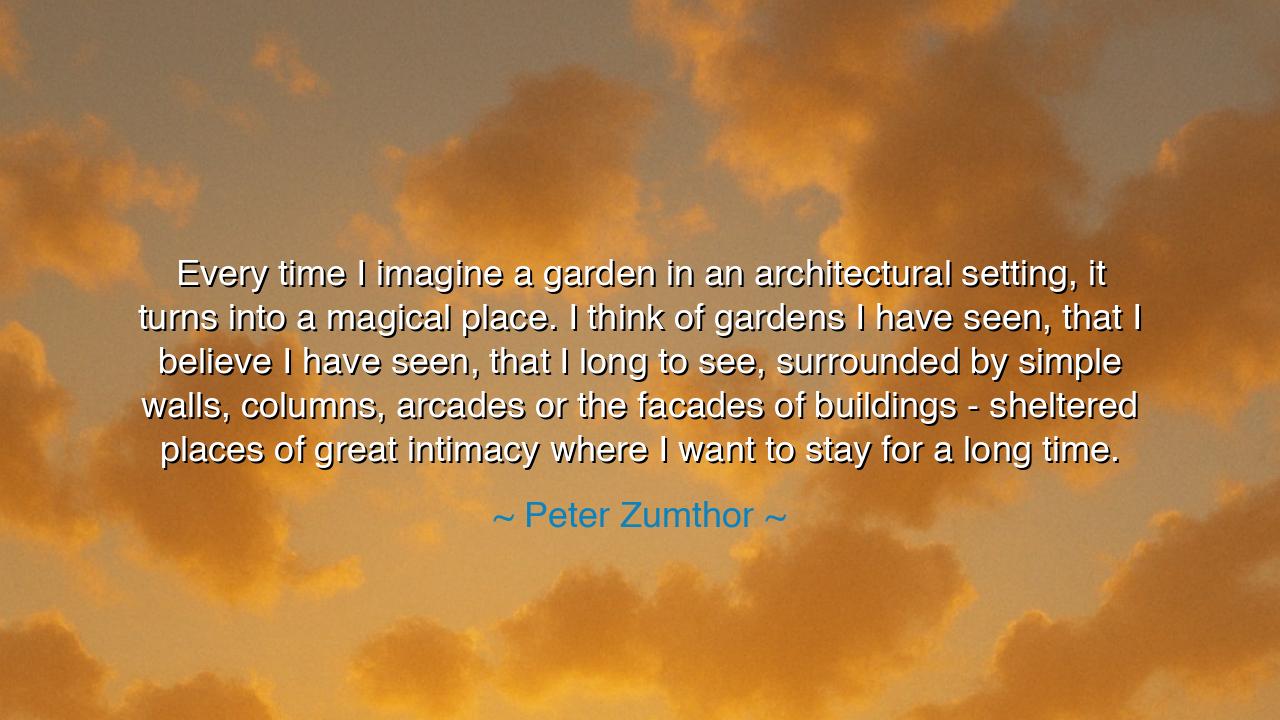
Every time I imagine a garden in an architectural setting, it
Every time I imagine a garden in an architectural setting, it turns into a magical place. I think of gardens I have seen, that I believe I have seen, that I long to see, surrounded by simple walls, columns, arcades or the facades of buildings - sheltered places of great intimacy where I want to stay for a long time.






In the ancient dance of life, there is a place where nature and architecture meet, where the human hand and the forces of the earth come together in a perfect union. The words of Peter Zumthor, "Every time I imagine a garden in an architectural setting, it turns into a magical place. I think of gardens I have seen, that I believe I have seen, that I long to see, surrounded by simple walls, columns, arcades or the facades of buildings - sheltered places of great intimacy where I want to stay for a long time," invite us into this sacred space, a place where beauty, peace, and the soul's deepest longings converge. His vision is not simply one of physical spaces, but of sanctuaries—places where the human spirit finds both solace and connection.
At the heart of Zumthor’s words is the garden, that timeless symbol of renewal, growth, and the natural world. But this garden is not a wild, untamed place. It is a garden that exists within a framework, within an architectural setting that enhances and elevates its beauty. It is within the walls of this human creation, whether they be simple walls, columns, or arcades, that the garden transforms into something magical. The walls are not barriers; they are guardians, protectors that allow the garden to exist in a state of intimacy. It is a space where one can retreat from the world, a space that invites you to linger, to reflect, and to experience a profound sense of peace.
The image of a garden enclosed by walls and supported by columns is an echo of the ancient gardens of Persia, where the concept of the paradise garden was born. These gardens were carefully designed, often surrounded by walls that separated them from the outside world. Within these walls, there was peace, balance, and harmony—qualities that represented the very essence of heaven on earth. These gardens were not just places of beauty, but places of reflection and spiritual renewal, designed to provide respite from the hardships of life. Just as Zumthor envisions, the gardens of ancient Persia were intimate spaces where one could feel a deep, personal connection to the world of nature, even as it was carefully shaped by human hands.
Consider also the gardens of ancient Greece, where philosophers and thinkers often gathered in spaces enclosed by columns and open to the sky. The Stoa of Attalos in Athens, an arcade that once stood as a meeting place for scholars, offered not only shelter from the harsh sunlight but a sanctuary for the mind. The architecture provided a sense of safety and containment, while the gardens within offered the space to engage with nature in a deep and reflective way. It is in this delicate balance between human creation and nature’s beauty that Zumthor’s words find resonance—this is the space of intimacy, a space where both mind and body can rest, and where the soul can grow.
Zumthor’s vision speaks to the universal human longing for places of peace and connection. In our busy, chaotic lives, we often forget the importance of creating spaces where we can retreat, where we can breathe deeply, where we can be truly present. It is easy to become lost in the noise of the world, to overlook the small, sacred spaces that offer us the chance to reconnect with ourselves and with the earth. The garden, especially one that is carefully crafted and enclosed, becomes a metaphor for the spaces in our lives where we must find the time to retreat, to reflect, and to rejuvenate.
This longing for the sacred space is not a new idea. It has been present throughout history, from the gardens of Babylon to the tranquil courtyards of medieval monasteries. These spaces were designed to provide peace, to offer an opportunity for the human soul to reconnect with the divine, with nature, and with its own deeper truths. The message is clear: the human spirit cannot thrive without places of quiet and intimacy, without places that invite us to be still and reflect.
Let us then, in our own lives, create spaces of intimacy and connection. Whether it is a garden, a room, or a quiet corner of our world, we must carve out spaces where we can find peace and be in harmony with the world around us. As Zumthor suggests, these are the places where we long to stay, where the soul can rest and grow. Do not wait for these spaces to appear on their own—create them, shape them, and make them your sanctuary. For in these spaces of solitude and connection, we will find not only refuge from the storm, but the nourishment of the spirit that we so often overlook in our busy lives. Build your garden, and in doing so, build a place where the beauty of nature and the depth of your soul can come together in perfect harmony.






AAdministratorAdministrator
Welcome, honored guests. Please leave a comment, we will respond soon